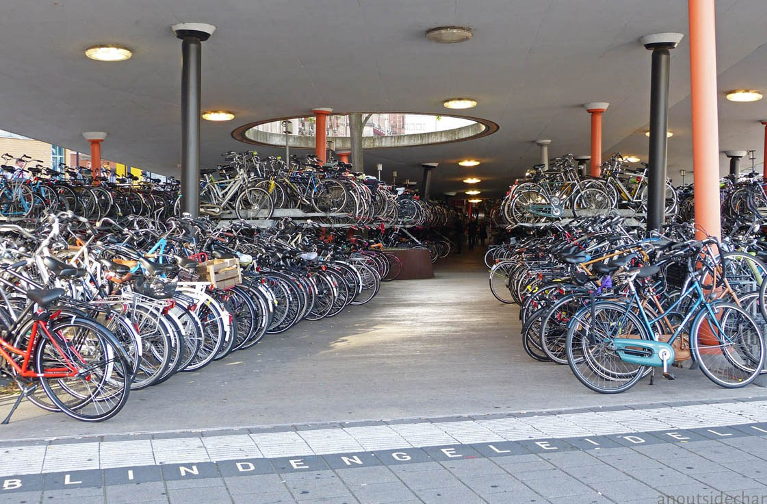Ed. note: The first post in this series can be found on Resilience.org here.
The Netherlands has a worldwide reputation as a bicycle-loving country – but bikes account for only a small proportion of kilometers travelled.
While the Dutch have given far greater official support to bicycling than other industrialized countries have, the dominance of car culture is still a fact of life in The Netherlands.
The government publication Transport and Mobility 2016 includes the section heading “The Dutch and their sacred cow” – and the authors aren’t referring to the bicycle. Rather, they note that over half of the adult population, and 71% of households, owns a car. This proportion rises to 84% of rural households, and 90% of high-income households.
Using figures from 2014, the publication states that 28% of trips made are by bicycle and 18% are by foot – but these trips tend to be short. Overall, 73% of kilometers traveled within the country are by car, with 9% by bike, 9% by train, 3% by other land-based public transport, and 3% on foot.
What are the most promising ways to shift a significant portion of this travel to carbon-emissions-free or low-carbon modes? Trips for education only account for 7% of kilometers traveled, and 80% of Dutch students under 15 already bike to school, so additional improvement in that category will be hard to achieve.
Commuting is the biggest single category of kilometers traveled. In common with other countries, the Dutch spend a disproportionate amount on roadways to accommodate more cars. But unlike most other countries, the Dutch are also investing substantially in infrastructure that makes it possible for more people to get to work without getting into a car.
Steel wheels and rubber tires
Building the Cycling City, published by Island Press, August 2018
In their excellent work Building the Cycling City: The Dutch Blueprint for Urban Vitality, Melissa and Chris Bruntlett discuss two areas of focus in efforts to increase bicycles’ modal share. (See the first part of a look at this book here.)
Cycling is the most common form of transportation in the country for short trips – 3 to 5 km – but most commutes are significantly longer than that. Fortunately, the country has also maintained a highly effective train network, and trains and bikes are now working symbiotically.
The Bruntletts note that “the nationwide [rail] system serves over 1.2 million passengers each and every day, half of whom bookend their train travel with bicycle rides.” (Building the Cycling City, page 140)
A small infrastructure program has been essential in promoting bike-train trips. Because the train system is already well used, there is no room on trains for bikes at rush hour. Therefore people are encouraged to keep one bike at home to ride to the local train station, and another one on the other end to pedal from the train station to the workplace. (That’s one reason the country now counts more bicycles than people.)
To be secure in this practice, people need safe bike parking adjacent to all train stations. Thus you can now find bike parking facilities at every train station – for hundreds of bikes in smaller towns, thousands of bikes in small cities, or tens of thousands of bikes in bigger cities.
This covered bike-parking facility is in the northern city of Groningen, adjacent to the train station.
The most impressive of these efforts is in the southern city of Utrecht. A large university town just a short train ride away from Amsterdam, Rotterdam, Leiden and Den Haag, Utrecht boasts the country’s busiest train station. To ensure that many of the rail passengers don’t need to rely on motorized transportation to get to or from the station, the station is now the site of the world’s largest bike garage, in a complex which holds 22,000 bikes and will hold 32,000 when completed.1
A state-of-the-art bike parking garage in downtown Utrecht. Gently sloping ramps wind from the street up through the three levels of parking, and electronic signs at the ends of aisles tell cyclists where free spaces are located.
The largest of the facilities holds 12,500 bikes of standard or close-to-standard sizes, while a separate facility can accommodate delivery bikes and bakfiets – long bikes with a large box that can hold up to three children. The garages are fully sheltered from weather, are constantly monitored, and most are open 24 hours a day while some sections are open “only” from 6 am to midnight. With so many cyclists using the facilities, it also makes sense to have a service and repair shop on site.
This attention to the needs of people with bikes may sound expensive. But clearly a 12,000-bike parking facility is far less expensive in both Euros and land area than a comparable-capacity car parking garage, or the kind of bus terminal that would be required to get all those people in and out of the train station by bus. And making the bike-train combo safe and convenient pays big dividends: Transport and Mobility 2016 notes that “An inhabitant of Utrecht differs from the inhabitants of the other provinces in making the most trips as well as the most kilometres by bicycle and train.”2 (Emphasis mine.)
Electrification
During my first week in The Netherlands, I was bent over the handlebars fighting a fierce wind when an elderly woman, sitting bolt-upright in the breeze, passed me with little apparent effort. I thought, “Wow, these Dutch people are really fit!” After the same thing had happened several more times, I caught on and learned to recognize electric-assist bikes3 by their characteristic battery location.
The Bruntletts note that
“Despite its mostly flat terrain, the Netherlands has emerged as the world’s largest pedelec market per capita, with electric bikes making up almost a third of new bicycle sales in 2016. Denmark is a close second ….” (Building the Cycling City, page 50)
There is a very good reason that The Netherlands and Denmark are such good markets for electric-assist bikes: they have the infrastructure that allows safe riding on an extensive network of protected bike lanes. Citing European Cyclists Federation development director Kevin Mayne, the Bruntletts say “the places with the best bike infrastructure are the ones that sell the most pedelecs, and the global e-bike market won’t fulfill its potential without great places to ride.” (Building the Cycling City, page 87)
But with safe infrastructure and traffic conditions in place, pedelecs have the potential to get people out of cars for longer commutes, not just short rides.
Within the city of Groningen where distances are small, cycling already has a 61 percent modal share, which the city hopes to increase to 67 percent. The Bruntletts write
“What would be more impressive would be to increase the current 12 percent of people arriving by bike from outside the city …. E-bikes will play a crucial role in any such increase by lengthening the average commute distance from eight kilometres to twenty kilometres with very little additional effort from riders.” (Building the Cycling City, page 64)
Elsewhere in the country, a small network of snelfietsroutes (“fast cycling routes”) are being built between major residential and commercial centers. Designed not for scenic appeal but with the straight-forward goal of promoting efficient bike commuting from city to city, these routes also appeal to cyclists who may not be up to an athletic workout five days a week, but would still like to bike their long-ish commutes. Electric-assist bikes have already proven very popular on these inter-city routes.
In general there is no need for specific public infrastructure to support pedelecs, if there is already a comprehensive network of safe lanes for ordinary bikes. Yet the presence of charging stations could make even longer rides practical – for example, the kind of rides that would use most of the battery power on a one-way trip, requiring a re-charge before the return trip. Some employers are now providing charging stations in bike garages at work, and I spotted this station outside a popular restaurant along a well-used cycling route.4
As with parking garages, charging stations for bikes take up much less space than charging stations for an equivalent number of cars. And since e-bikes consume far less energy than e-cars, charging infrastructure is far less technically demanding and far less expensive. (Pedelec batteries are rated in Watt Hours while electric car batteries are rated in KiloWatt Hours.)
Post-script: follow the red-brick road?
As Melissa and Chris Bruntlett so engagingly document, The Netherlands has done far more than other industrialized countries to safely integrate bicycles into their overall transportation system, with great results for public health and for the vitality of their cities. One result of the national habit of cycling is that the transportation sector in The Netherlands is accountable for just one-fifth of the country’s carbon emissions, compared to one-third in the US.
While the Dutch have a commanding lead when it comes to effective promotion of everyday cycling, they have achieved this in the context of a transport system where cars remain dominant. Most households own cars, most kilometers are traveled by car, and many features of daily life and of the national landscape will be entirely familiar to people living in other car cultures.
Outside the core urban areas, a hierarchy of speed rules just as it does in many other countries – the spacing is just tighter. The US Library of Congress report “National Funding of Road Infrastructure: Netherlands” states
“According to European statistical sources, the highest motorway density in Europe is found in the Netherlands (78 km per 1000 km² on average in 2009), Luxembourg (59), and Belgium (58).”5
As noted earlier, more affluent citizens are more likely to own and use cars for their commutes, and they also tend to commute longer distances. For a small, densely populated country which clearly values its farmland, the motorways take up a surprising amount of space in rural areas. Furthermore, dedicated high-speed car-and-truck lanes also impose their geometry on slower-speed travellers. While cycling through the countryside, for example, you need to find the infrequent roads that cross the motorways, where you may bike up and over the dedicated high-speed transport lanes. Likewise if you’re pedaling a bikeway alongside an expressway, you need to take a detour each time you come to an interchange, with a wide curve around the sprawling clover-leaf interchanges. These impositions on cyclists and other low-speed travellers are deemed necessary to allow uninterrupted high-speed travel on the expressways.
But what if, as a world community, we finally embark on the serious kind of energy and lifestyle revolution that is needed to adequately reduce carbon emissions? Or – a more likely scenario in our current political scene – what if we run short of cheap fossil fuels without finding a technological miracle to allow our high-energy lifestyles to continue with low-intensity fuels such as solar and wind-power? What sort of challenges will we face in transforming our transportation infrastructures?
The Netherlands will clearly have a head start in such a transition. Yet as I cycled through the countryside, it often struck me that there too, the road system is astonishingly overbuilt. Frequently I found myself biking on a dedicated bike path, beside a two-lane service road, beside a multi-lane expressway, with another service road and bike path on the other side.
A generation or a few from now, when our descendants have through choice or necessity transitioned to a low-energy, and therefore low speed, transportation system, will they still need or want to devote such wide swaths of countryside to transportation? And if not, how will they repurpose some of those thousands of hectares of heavy-duty pavement?
In my first few days biking through The Netherlands I wasn’t always happy that many bike lanes are routed along old, somewhat rough brick roads – the surface just wasn’t as smooth, fast or comfortable to bike on as a well-maintained asphalt surface.
But then I reflected on the almost endless repairability and reusability of those brick roads. From my own work experience I know that “recycling” asphalt and concrete pavements demands large amounts of high-intensity energy resources. But in The Netherlands I saw workers with simple hand tools re-laying old bricks and re-creating good-as-new roads.
I won’t be around to see it, but in the long term my guess would be that the centuries-old red brick roads of The Netherlands will be the ones that are renewed for centuries to come.
Next week: a look at new cycling infrastructure in Valencia, Paris and London in light of the infrastructure in The Netherlands.
Top photo: covered bike-parking facility next to train station in Groningen.
Footnotes
1 “A third big bicycle parking garage for Utrecht”, 17 April 2018, Bicycle Dutch website
2 Transport and Mobility 2016, Statistics Netherlands, page 19
3 While the “electric bikes” now seen in North America most often don’t require the rider to pedal at all, the variety common in The Netherlands has a motor which only kicks in while the rider is pedaling. These electric-assist or pedelec bikes thus amplify a rider’s strength, but don’t allow completely effort-free riding.
4 On the downside, ubiquitous availability of charging stations could lead more people to rely on the battery-assist mode almost exclusively, resulting in a steep drop-off in the exercise levels and health benefits of e-bike converts. See discussion of a recent European study at “Riding e-bikes does not lead to health benefits”, on A view from the cycling path, September 12, 2018
5 National Funding of Road Infrastructure: Netherlands”, US Library of Congress













